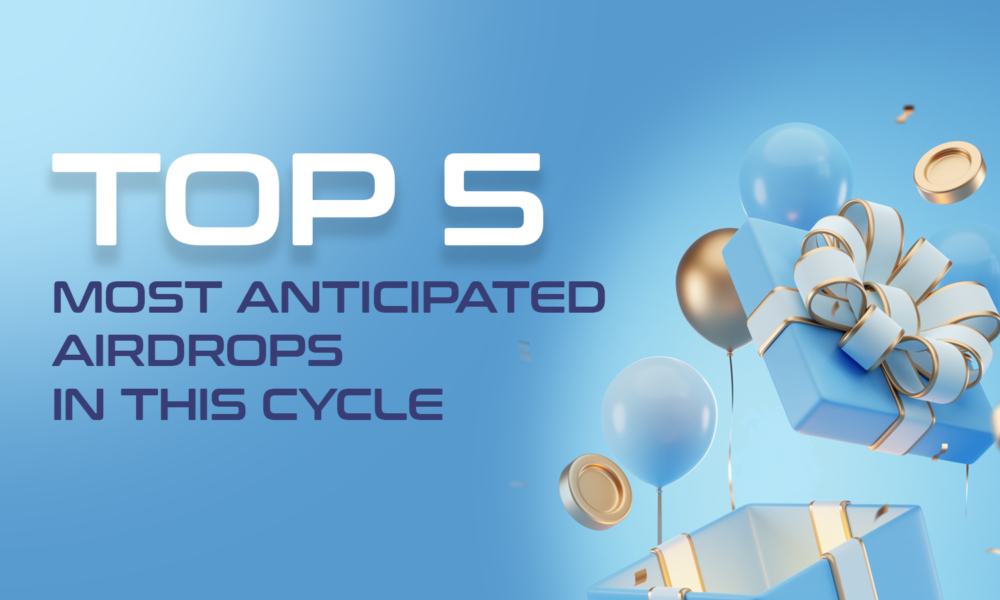Top 5 Most Anticipated Airdrops in This Cycle

Airdrops are a common strategy that crypto projects often adopt to reward and encourage contribution, participation and early adoption amongst their users. The entire point of the strategy is to drive brand awareness and convince crypto natives to engage or interact with a project’s tech in exchange for rewards at a later time. It’s an incentive-oriented model that has become a significant part of crypto culture.
As far as web3 marketing goes, airdrops are one of the most effective tools for promoting a project and driving adoption. We see this impact in the number of high-profile airdrops within the crypto industry over the last few years, some of which are directly responsible for reigniting crypto interest and driving mainstream acceptance.
The first is the Uniswap airdrop of 2020, where the decentralized exchange protocol Uniswap airdropped $6.43 billion worth of its native UNI token to early adopters. At the time, one UNI token was valued at an all-time high (ATH) price of $42.28. To this day, Uniswap’s airdrop remains the largest airdrop in crypto history.
In the years that followed, there would be several other high-profile drops, such as dYdX, Loot and Internet Computer in 2021, ApeCoin, Optimism and LooksRare in 2022 and Arbitrum, Celestia, and Jito in 2023. These airdrops, and several others within the same period, have distributed around $26.6 billion to crypto natives all around the world.
2024 looks like it would feature several high-profile airdrops as well. There have already been some huge airdrops in the year’s first half, such as the Jupiter and Dymension airdrops. As we enter the year’s second half, there could be even more amazing airdrops in store. From all indications, this cycle could be one for the books. Let’s look at five of the most anticipated airdrops this year.
Jupiter (JUP)
Blockchains such as Solana house several Decentralized Exchange (DEX) platforms where users can participate in Decentralized Finance (DeFi) activities like swapping and lending. While this means that users are spoilt for choice concerning options, it also means varying price rates across these platforms due to liquidity conditions.
This situation results in a poor user experience, as users would either have to go across these platforms looking for the best rates or settle for one with higher rates than they are willing to pay. It is for this reason that Jupiter exists today.
Jupiter is a DEX aggregator designed to improve the DeFi experience within the Solana ecosystem. It allows users to access liquidity and essentially interact with other DEXs from its interface. In doing so, Jupiter enables users to access the “best rates” for their swaps without interacting with multiple exchange platforms than they usually would, vastly improving the DeFi user experience.
Earlier this year, the Jupiter airdrop was launched, and approximately $700 million worth of JUP tokens were claimed by close to a million wallets. The JUP airdrop is currently the biggest airdrop this year and the biggest Solana airdrop of all time. There are rumours that a second JUP airdrop for JUP token stakeholders is set to launch in the second quarter of the year.
Dymension (DYM)
Dymensions’s DYM token airdrop is the second biggest airdrop in 2024 so far. Dubbed the “genesis rolldrop”, the total value of the airdrop stands around $390 million, with users from various chains and communities receiving a portion of the 700 million DYM tokens distributed. DYM went out to wallets on Solana, Celestia, Ethereum, Arbitrium, Base, Blast, and Optimism and to NFT holders of Ethereum’s Pudgy Penguins and Solana’s Madlads and Tensorians.
Reports suggest that more than a million wallets could have claimed the airdrop, but ultimately, only 582,523 did. The remaining tokens are said to have been redistributed amongst other users.
The DYM token plays a significant role in the Dymension ecosystem, facilitating network payments, staking and stake delegations, block reward payments and token burn events. It is the lifeblood of Dymension, a modular blockchain network that introduces the concept of Roll-apps and opens up new possibilities in the creation of Decentralized Applications (dApps).
Wen Coin (WEN)
Nothing says bull season like an influx of meme coins in the market. From Dogecoin to Shiba Inu to Floki and Bonk, meme coins have become a familiar feature of every bull run. In this cycle, Solana meme coins are leading the charge, and Wen coin is at the forefront of the movement.
Meme coins are usually born out of popular Internet memes or social trends on social media like X (formerly known as Twitter) or Reddit, and the Wen token is no different. The inspiration for the Solana-based meme coin comes from the community of crypto degens, which can be found in the comments section of crypto projects asking when they’ll mint a new token. The token essentially pays homage to this community.
Wen coin is renowned within the crypto space as the first-ever community coin based on fractional NFTs. The team behind Wen coin turned a poem by X user @weremeow into an NFT and divided it into one trillion pieces, eventually becoming Wen tokens.
DEX aggregator Jupiter airdropped the meme coin, and over a million Solana wallets were eligible to claim it – including active Jupiter users in the last six months, holders of several popular Solana NFTs and owners of the Solana Saga smartphone.
Grass (GRASS)
Grass is a crypto project that refers to itself as “the data layer of AI”. Its goal is to be a decentralized network that accesses the public web and gets the required data to train AI models. Since the training data an AI model uses determines how accurate and unbiased its answers will be, AI models must be provided with genuine, pure and reliable data so they do not become influenced by human biases. Grass provides this data by providing a platform for users to run nodes and sell portions of their internet that aren’t in use.
The way it works is simple. Users run a node on Grass and sell unused parts of their network. AI labs then pay for this resource, visit public websites via the Grass network and scrape AI data. This data is then used to train the next generation of AI models. At the same time, ordinary people receive compensation for their network resources and contribute to developing healthy, unbiased artificial intelligence.
The work that Grass is doing will prevent the monopoly of web data that centralized AI companies seek to establish. The project believes that these companies do not have the right to a public resource, such as the Internet, and by providing a decentralized data provisioning platform, it will be able to right some of the wrongs of Web 2.0 and allow everyone to contribute and benefit from the growth of AI.
There is a rumoured airdrop for users running grass nodes early in the second half of the year. Already, grass points are trading on OTC marketplaces on Solana like WhaleMarkets, and there is a general feeling that it could be one of the biggest airdrops the industry has seen in recent times.
InterSwap (ISWAP)
InterSwap is a fully composable native asset cross-chain automated market maker (AMM) protocol. In simple terms, it is a platform that allows users to exchange assets across multiple chains and instantly access liquidity pools across these chains and AMMs. It is built on the Axelar network, a platform solving the interconnectivity issue in crypto by transforming interoperability into a programmable layer.
A major problem within the crypto industry is the inability of blockchains to interact and communicate with each other. Blockchains, by default, are designed to be independent and self-sufficient, requiring little to no input from external forces. In the early days of crypto, this was alright and acceptable.
However, with the emergence of new concepts like DeFi, blockchains now need to be able to send information and assets across chains and interact with other blockchains. The alternative would be for users to shoulder the burden and move manually across different chains to achieve their goals. Obviously, this would result in a bad user experience.
To solve this interoperability problem, solutions like bridges, liquidity pools and atomic swaps have emerged, but they all share the similar downside of being too expensive and prone to attacks. There is a need for a safer, cheaper and more efficient way to achieve cross-chain interoperability, and this is what Interswap sets out to provide.
InterSwap makes the creation of two types of cross-chain liquidity pools possible – weighted pools for non-pegged tokens and stable pools for pegged tokens. Additionally, it is blockchain agnostic, meaning it supports all kinds of blockchains and is non-reliant on intermediaries, such as wrapped/pegged assets, bridge tokens or intermediate chains.
InterSwap’s public testnet is now live, and there is an ongoing campaign to reward users that interact with it. All that is required to participate in this campaign is completing tasks on the popular social platform, Galxe, and interacting with the InterSwap testnet daily by swapping or adding liquidity. Doing so will earn you InterSwap points (IP), which will be converted into rewards and announced later.
InterSwap has allocated 7% of its total supply towards its community, and participating in the ongoing campaign will increase your chances of receiving rewards from that prize pool.
Conclusion
It’s already shaping out to be a great year for airdrops, as seen by the success of airdrops in the first half of the year, such as Dymension, Jupiter, and Wen Coin. As the year’s second half begins and the bull run imminent, we will likely see more high-profile airdrops. If you missed any of the airdrops from the first half of this year, you want to position for the others that may be coming at some point in the year, such as Grass and InterSwap.






